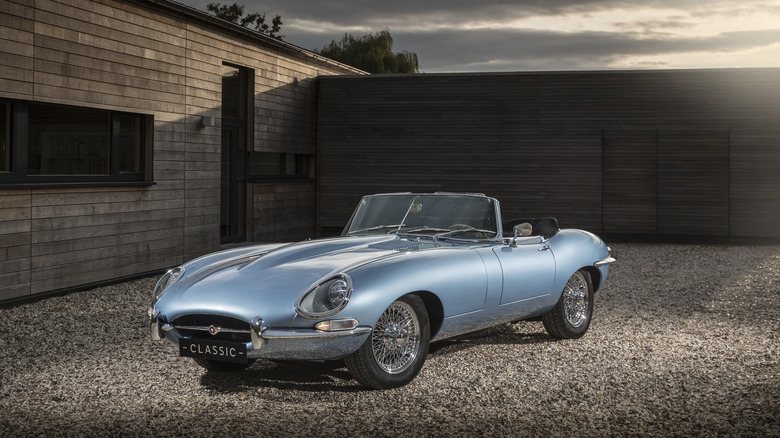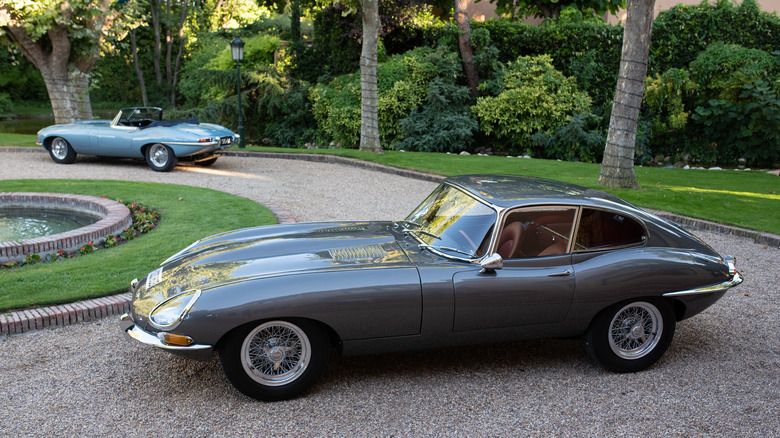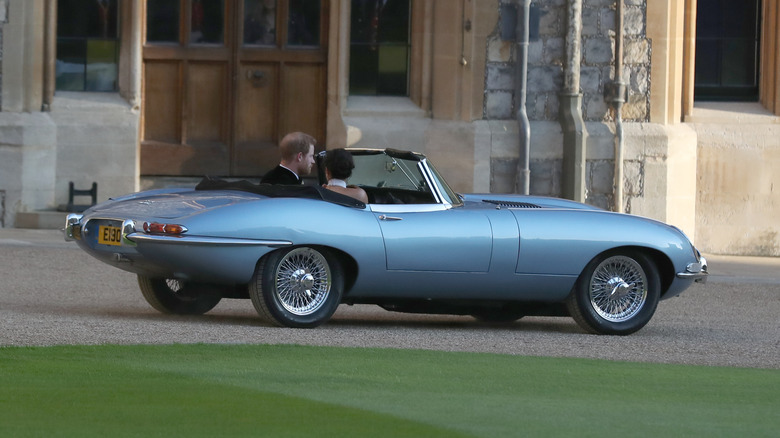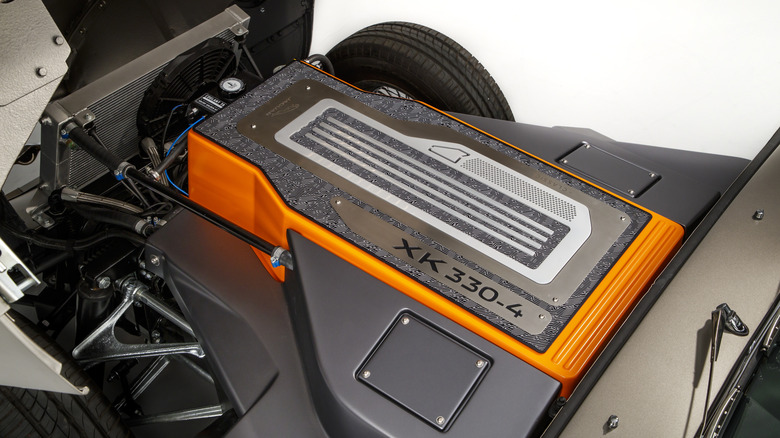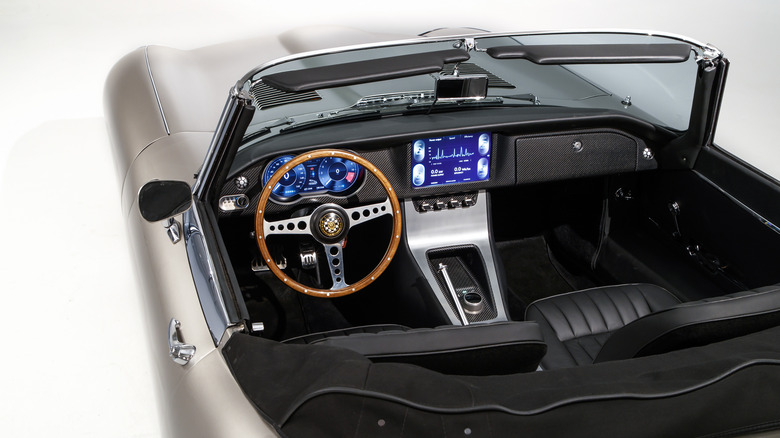Why Everyone Drools Over Harry And Meghan's Jaguar
Fans of the royal car collection wouldn't have been too surprised to see Prince Harry and Meghan Markle leave their 2018 wedding ceremony at Windsor Castle in a Jaguar E-type. It's a beautiful British convertible fitting for the sunny weather that day, and would look great in the garage next to King Charles' blue Aston Martin DB6 Volante, detailed by Aston Martin Magazine and also used as Prince William's wedding car.
Before we get to the real reason why Harry and Meghan's Jaguar is so special, it's time for a quick E-type history lesson.
Revealed at the 1961 Geneva motor show, the Jaguar E-type (marketed as the XKE in the U.S.) went down in a storm. It was so popular with attendees and the press, that Jaguar tasked test driver Norman Dewis with driving a second car from the factory in Coventry, England through the night to appear at the second day of the Switzerland show.
The most beautiful car in the world
As famous as Dewis' flat-out drive through France is what Enzo Ferrari made of the new Jag. The Ferrari founder is claimed to have described the E-type as "the most beautiful car in the world." But, as is often the case with Enzo, it's a second-hand quote that is tricky to pin down. The closest we'll likely get is an account from Dewis, who claimed the Ferrari boss approached the Jaguar stand and said, in Italian and cited by RM Sotheby's, "Congratulations! What a truly beautiful car, it must be the most beautiful car in the world!"
In typical Enzo fashion, he reportedly went on to say: "But you know, it has one fault? It does not have a Ferrari badge on it!"
Jaguar itself describes the E-type as a car that "defined its generation," adding: "It was everything the 60s stood for and became the car of choice for the international jet-set, super models, and rock stars alike."
Powered by a 268 horsepower, 3.8-liter, six-cylinder engine, the E-type had a claimed 0-60 mph time of 6.9 seconds, a top speed of 150 mph, and was available in convertible roadster and hardtop coupe forms. Priced from just £2,097 (about $67,000 today), it was around half the price of its rivals, says Autocar.
Concept Zero
But the car driven by Prince Harry didn't have an engine. Instead, it was fully electric. Called the "Concept Zero," it was revealed by Jaguar eight months earlier in September 2017, but with no mention of its future royal duties.
The car is based on a 1968 Series 1.5 E-type, Jaguar says, produces 220 kW (295 hp) and has a 0-60 mph time of 5.5 seconds; top speed is a claimed 150 mph. The company also says the one-off concept is 80 kg lighter than the original, with a 40 kWh battery pack located under the hood, and electric motor with reduction gear ahead of the driver where the car's transmission used to be.
Jaguar says how the car's chassis, suspension, and brakes were not changed, and this helped simplify the conversion and homologation process. Tim Hannig, then-director of Jaguar Land Rover Classic, said: "We have integrated the new electric powertrain into the existing E-type structure, which means a conventional engine could be reinstalled at any point. We think this is essential as it ensures a period Jaguar remains authentic to its DNA."
The car is fitted with the rotary gear selector of a contemporary Jaguar, while a new carbon fiber dashboard features a retrofitted touchscreen display and digital instrument cluster. Naturally, there is no tailpipe sprouting from the car's sweeping rear end, but the front is home to new LED headlamps. A charging socket sits behind the original fuel flap.
Coventry via Croatia
Although Jaguar's Classic division in Coventry built the car, it did so with help from Croatian auto startup Rimac. Little-known at the time, Rimac has since taken control of Bugatti, counts Porsche among its investors, and is currently producing the Nevera — an electric hypercar with 2,000 horsepower and officially the world's fastest EV.
Speaking at the car's reveal in 2017, Mike Goodbun, the PR manager of Jaguar's Special Vehicle Operations, said to Fully Charged Show: "The reaction has been phenomenal already to this car." Goodbun added: "This car was engineered in conjunction with Rimac in Croatia for some of the electrical expertise. We supplied them a brief and have worked with them to develop this driveline in a way that meets our intentions for the reversibility of the conversion."
Such was the concept's reception, Jaguar announced in August 2018 — three months after the royal wedding — that the electric E-type would go into production, with the first deliveries expected in summer 2020. The company predicted a range of 170 miles and showed off a second E-type Zero model, painted Bespoke Bronze, at Monterey Car Week. It was to be priced at around £300,000, TopGear reported.
Jaguar pulls the plug
Unfortunately, and despite the car receiving widespread praise from the press and interested buyers alike, Jaguar contacted customers in November 2019 to say the project had been paused. A letter sent to interested customers (and obtained by Electrek) said: " ... we have taken a difficult decision to pause the development of the production vehicle for the time being."
Jaguar has not yet returned to the project, at least publicly. Jaguar did not give a clear answer as to why the project was halted, though there is the potential for it to return in the future. This means Harry and Meghan were likely the only people outside of the company to have driven the E-type Zero, and there's no indication that production will recommence any time soon. Instead, Jaguar offers gas-powered E-type restorations under the "Reborn" name, as well as newly-built examples of the XKSS, D-type and C-type.
